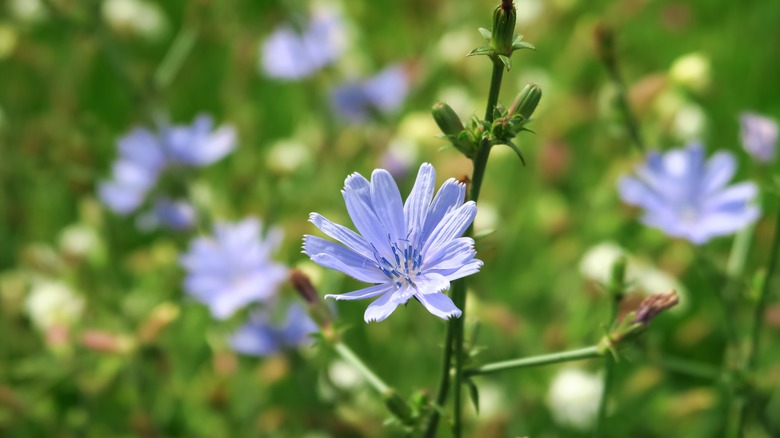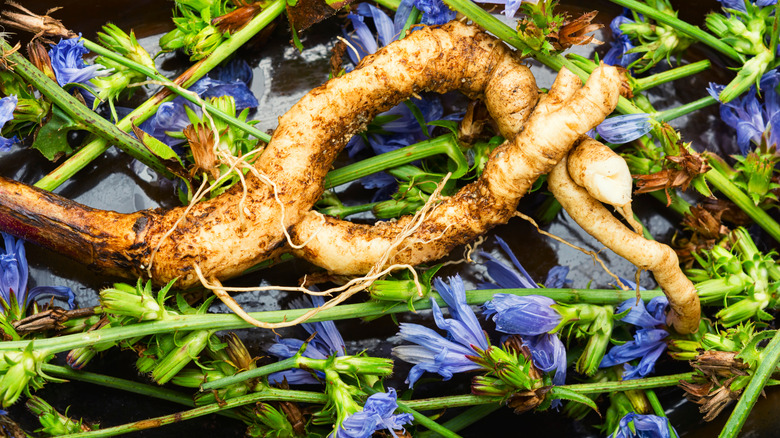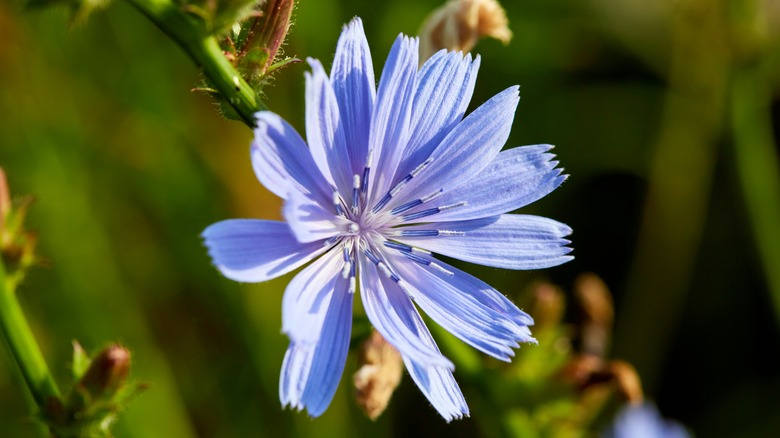The Blue Chicory Flower Is A Weed You Don't Want Lurking In Your Yard
Every spring and summer, we look forward to adding new flowers to our outdoor spaces and watching those we previously planted come back into full bloom. However, sometimes new species spring up around our yards, some of which might look pretty and add a pop of color but may actually be harmful to your garden. The blue chicory flower – also known as blue sailors, coffeeweed, Italian dandelion, and succory — is lovely in its light blue shade and has small florals that resemble a daisy. However, chicory flowers are invasive plants that will spread in your garden and compete for resources like sunlight, water, space, and other essential nutrients.
Native to Europe and part of the Asteraceae plant family, the blue chicory flower is commonly found along roadsides and in pastures but can still make an appearance in our yards. Blue chicory seeds carry and stay viable for a handful of years, rapidly spreading and edging out other plants around them. To keep your lawn and garden healthy, you should aim to remove these flowers as they sprout by weeding and mowing and consider taking preventative measures so that they won't return.
How blue chicory can be harmful
Like many invasive plant species, the blue chicory flower is durable and can thrive in various conditions. Its long taproots allow it to obtain water and other nutrients that neighboring plants might not be able to reach. Pair this with the high number of seeds it spreads and its rugged, bristly stems, and you've got a more challenging weed to mow down and get rid of. Even leaving portions of its roots behind after being cut or ripped out can be a window for the plant to resprout. You may initially think these small and vibrant flowers are harmless, but allowing them to spread throughout your yard will directly challenge your other plants' access to vital growth needs. It's an invasive weed you'll want to get rid of if it makes its way into your garden.
Blue chicory not only poses a threat to the health of plants around your home but also detracts from the visual appeal of your outdoor space. With stalks that can reach heights of 3 to 5 feet, they tower above other plants, their thick stems creating an untidy, weed-infested look. In certain states, such as Colorado, blue chicory is classified as a noxious weed, necessitating its removal or management in many areas. These flowers typically start blooming in June and continue until the first frost, making early summer through the start of fall the ideal time to be vigilant and implement preventative measures.
Removing blue chicory and preventing its return
If you have found a lot of blue chicory littering your yard, eliminating them may be a bit of an uphill battle, but it can certainly be done. While mowing and weed whacking can, of course, cut them down, it does not help much with regrowth from seeds or left-behind roots. Removing chicory mechanically is still highly effective; however, it will involve pulling out the plant by the roots or digging them out. If mechanical removal doesn't get the job done, consider chemical treatment. General herbicides will do the trick. When removing chicory, you don't have to waste the plant. It is entirely edible and can be used in your meals by adding petals to salads, picking the buds, sautéing the leaves, or grinding the root into a coffee.
Prevention is just as crucial as elimination, as you will want to keep the blue chicory from returning and may be able to prevent them from ever sprouting. You can plant tall grasses and flowers with robust root systems to crowd out the space needed for chicory to grow. Keeping up with lawn maintenance tasks, such as routine mowing and fertilization, will also help keep weeds like chicory from invading your yard. If you love the look that blue chicory adds to your garden but need something that won't threaten other plant life, consider these blue and periwinkle perennials instead: dwarf larkspur, prairie flax, grand mesa beardtongue, and smooth aster.


